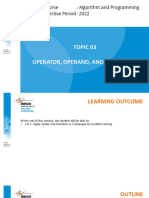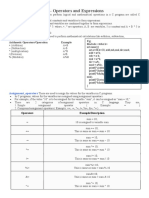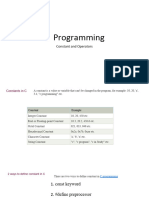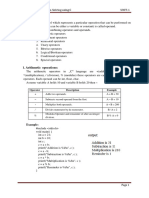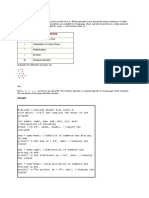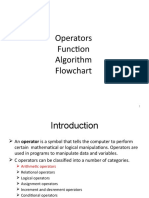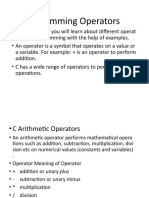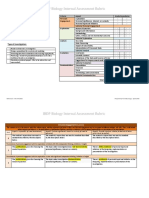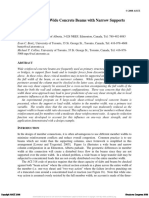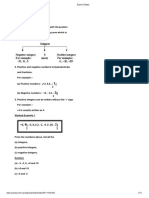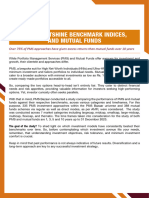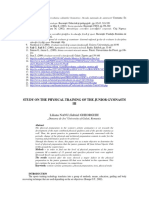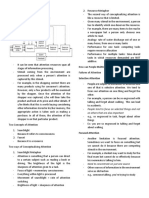1
KATHMANDU UNIVERSITY SCHOOL OF
MANAGEMENT
Civil 1st year 1st semester
COM 102 : 3 Credit Hours
4. Operators in C
2
Outline
4.1 Arithmetic Operators
4.2 Assignment Operators
4.3 Logical Operators
4.4 Bitwise Operators
4.5 Unary Operator
4.6 Conditional Operator
3
Operators
An operator is a symbol that tells the compiler to perform specific mathematical or logical
functions.
These C operators join individual constants and variables to form expressions.
C language is rich in built-in operators and provides the following types of operators:
Arithmetic Operators
Increment and Decrement Operators
Assignment Operators
Logical Operators
Relational Operators
Conditional Operator
Bitwise Operators
Special Operators
4
Arithmetic Operators
Arithmetic Operators are used to performing mathematical calculations like addition (+),
subtraction (-), multiplication (*), division (/) and modulus (%).
Arithmetic Operators: Example
#include<stdio.h>
5
int main(){
int a = 40, b = 20;
int add,sub,mul,div,mod;
add = a+b;
sub = a-b;
mul = a*b;
div = a/b;
mod = a%b;
printf("Addition of a, b is : %d\n", add);
printf("Subtraction of a, b is : %d\n", sub);
printf("Multiplication of a, b is : %d\n", mul);
printf("Division of a, b is : %d\n", div);
printf("Modulus of a, b is : %d\n", mod);
return 0;
}
Format specifier
6
• The format specifiers are used in C for input
and output purposes.
• Using this concept the compiler can Integer overflows occur when the result of an arithmetic
understand that what type of data is in a operation is a value, that is too large to fit in the available
variable during taking input using the storage space.
scanf() function and printing using printf()
function.
• Here is a list of format specifiers.
#include <stdio.h>
main() {
char ch = 'B';
printf("%c\n", ch); //printing character data
//print decimal or integer data with d and I
int x = 45, y = 90;
printf("%d\n", x);
printf("%i\n", y);
float f = 12.67;
printf("%f\n", f); //print float value
printf("%e\n", f); //print in scientific notation
int a = 67;
printf("%o\n", a); //print in octal format
printf("%x\n", a); //print in hex format
char str[] = "Hello World";
printf("%s\n", str);
printf("%20s\n", str); //shift to the right 20 characters including the string
printf("%-20s\n", str); //left align
printf("%20.5s\n", str); //shift to the right 20 characters including the string, and print string up to 5 character
printf("%-20.5s\n", str); //left align and print string up to 5 character
}
8
Increment and Decrement Operators
Increment and Decrement Operators are useful operators generally used to minimize the
calculation.
Increment ++ increases the value by 1 whereas decrement -- decreases the value by 1.
These two operators are unary operators, meaning they only operate on a single operand.
○ ++x is same as x = x + 1 or x += 1
○ --x is same as x = x - 1 or x -= 1
Increment and decrement operators can be used only with variables. They can't be used
with constants or expressions.
int x = 1, y = 1;
++x; // valid
++5; // invalid - increment operator operating on a constant value
++(x+y); // invalid - increment operating on an expression
9
Prefix and Postfix Increment and Decrement
Increment/Decrement operators are of two #include<stdio.h>
types:
int main() {
1. Prefix increment/decrement operator.
int var1 = 5, var2 = 5;
2. Postfix increment/decrement operator.
// 5 is displayed
// Then, var1 is increased to 6.
printf("%d\n", var1++);
// var2 is increased to 6
// Then, it is displayed.
printf("%d\n", ++var2);
return 0;
}
10
…
11
Prefix increment/decrement
The prefix increment/decrement operator immediately increases or decreases
the current value of the variable. This value is then used in the expression. Let's
take an example:
y = ++x;
Here first, the current value of x is incremented by 1. The new value of x is then
assigned to y.
Similarly, in the statement:
y = --x;
the current value of x is decremented by 1. The new value of x is then assigned to
y.
The following program demonstrates prefix increment/decrement operator in
action:
12
…
#include<stdio.h>
int main()
{
int x = 12, y = 1;
printf("Initial value of x = %d\n", x); // print the initial value of x
printf("Initial value of y = %d\n\n", y); // print the initial value of y
y = ++x; // increment the value of x by 1 then assign this new value to y
printf("After incrementing by 1: x = %d\n", x);
printf("y = %d\n\n", y);
y = --x; // decrement the value of x by 1 then assign this new value to y
printf("After decrementing by 1: x = %d\n", x);
printf("y = %d\n\n", y);
// Signal to operating system everything works fine
return 0;
}
13
Postfix Increment/Decrement operator
The postfix increment/decrement operator causes the current value of the variable to be
used in the expression, then the value is incremented or decremented. For example:
y = x++;
Here first, the current value of x is assigned to y then x is incremented.
Similarly, in the statement:
y = x--;
the current value of x is assigned to y then x is decremented.
14
#include<stdio.h>
int main()
{
int x = 12, y = 1;
printf("Initial value of x = %d\n", x); // print the initial value of x
printf("Initial value of y = %d\n\n", y); // print the initial value of y
y = x++; // use the current value of x then increment it by 1
printf("After incrementing by 1: x = %d\n", x);
printf("y = %d\n\n", y);
y = x--; // use the current value of x then decrement it by 1
printf("After decrementing by 1: x = %d\n", x);
printf("y = %d\n\n", y);
// Signal to operating system everything works fine
return 0;
}
15
Assignment Operators
An assignment operator is used for assigning a value to a variable. The most common
assignment operator is =
16
Assignment operators: Example
#include <stdio.h>
int main()
{
int a = 5, c;
// Working of assignment operators
c = a; // c is 5
printf("c = %d\n", c);
c += a; // c is 10
printf("c = %d\n", c);
c -= a; // c is 5
printf("c = %d\n", c);
c *= a; // c is 25
printf("c = %d\n", c);
c /= a; // c is 5
printf("c = %d\n", c);
c %= a; // c = 0
printf("c = %d\n", c);
return 0;
}
17
Relational Operators
A relational operator checks the relationship between
two operands.
If the relation is true, it returns1; if the relation is false, it
returns value 0.
Relational operators are used in decision making and
loops.
A = 5 , B = 6;
A==B;
A!=B;
18
Relational Operators: Example
#include <stdio.h>
int main()
{
int m=40, n=20;
if (m == n)
{
printf("m and n are equal");
}
else
{
printf("m and n are not equal");
}
return 0;
}
19
Classroom Assignment
WAP to find a larger number among two numbers input by the user (use
relational operator for the comparison).
Hints:
A =6
B=7
If (A>B) {
Pri…. A is greater.
}
Else { b is greater
20
Logical Operators
C provides three logical operators when we test more than one condition to make
decisions.
These are: && (meaning logical AND), || (meaning logical OR) and ! (meaning logical
NOT).
&& and | | are binary operators while ! is a unary
operator.
Binary operators act upon a two operands to
produce a new value.
21
AND (&&) operator
The logical AND operator (&&) returns the boolean value true if both operands are true and
returns false otherwise.
Syntax: operand1 && operand2
Truth table of AND operator is:
22
OR (II) operator
The logical OR operator (||) returns the boolean value true if either or both operands is true
and returns false otherwise.
Syntax: operand1 || operand2
Truth Table of OR operator is:
23
NOT (!) operator
The logical NOT operator(!) negates the value of the condition.
If the value of the condition is false then it gives the result true. If the value of the
condition is true then it gives the result false.
Syntax: !operand
The truth table of logical NOT operator is:
24
Logical Operator: Example
#include <stdio.h>
int main() {
int m=40,n=20;
int a=20,p=30;
if (m>n && m !=0) {
printf("&& Operator : Both conditions are true\n"); }
if (a>p || p!=20) {
printf("|| Operator : Only one condition is true\n"); }
if (!(m>n && m !=0)) {
printf("! Operator : Both conditions are true\n"); }
else {
printf("! Operator : Both conditions are true. " \
"But, status is inverted as false\n"); }
return 0;
}
25
Conditional Operator
The Conditional Operator in C, also called a Ternary operator, is one of the
Operators, which used in the decision-making process.
#include <stdio.h>
int main()
{
int age; // variable declaration
printf("Enter your age");
scanf("%d",&age); // taking user input for age variable
(age>=18)? (printf("eligible for voting")) : (printf("not eligible for voting")); // conditional
operator
return 0;
}
Syntax:
(Text Expression)? statement1 : statement2;
26
Bitwise Operators
The bitwise operators are the operators used to perform the operations on the
data at the bit-level.
When we perform the bitwise operations, then it is also known as bit-level
programming.
It consists of two digits, either 0 or 1.
It is mainly used in numerical computations to make the calculations faster.
1
0000 0000 0000 0001
256 128 64 32 16 8 4 2 1
1/17/2022
27
Bitwise Operators in C
Operator Meaning of Operator
& Bitwise AND Operator
| Bitwise OR Operator
^ Bitwise exclusive OR Operator
~ Bitwise NOT Operator (Unary Operator)
<< Left Shift Operator
>> Right Shift Operator
28
Bitwise AND Operator
Bitwise AND operator is denoted by the single ampersand sign (&). Two
integer operands are written on both sides of the (&) operator.
If the corresponding bits of both the operands are 1, then the output of the
bitwise AND operation is 1; otherwise, the output would be 0.
x y x&y
0 0 0
0 1 0
1 0 0
1 1 1
29
Bitwise AND Operator
We have two variables a and b.
Int a =6;
Int b=4;
The binary representation of the above two variables are given below:
………….8 4 2 1
a = 0110
b = 0100
--------------------
01 00
When we apply the bitwise AND operation in the above two variables,
i.e., a&b, the output would be:
Result = 0100
30
Example:
Checking for Odd and Even Numbers using Bitwise AND (&) Checking if a number is a power of 2
#include <stdio.h>
#include <stdlib.h> #include <stdio.h>
#include <stdlib.h>
int main(){ int main(){
int x=3; int a=32;
if(a > 0 && (a & (a - 1)) == 0){
if(!(x&1)){ printf("%d is a power of 2", a);
printf("x is even"); }
} else { return EXIT_SUCCESS;
}
printf("x is odd!");
}
}
31
Bitwise OR operator
The bitwise OR operator is represented by a single vertical sign (|).
Two integer operands are written on both sides of the (|) symbol. If the bit value of any of
the operand is 1, then the output would be 1, otherwise 0.
x y x|y
0 0 0
0 1 1
1 0 1
1 1 1
32
Bitwise OR Operator
We consider two variables,
a = 23;
b = 10;
The binary representation of the above two variables would be:
a = 0001 0111
b = 0000 1010
When we apply the bitwise OR operator in the above two variables, i.e., a|b ,
then the
output would be:
Result = 0001 1111
33
Bitwise exclusive OR operator
The ^ operator is bitwise XOR. The usual bitwise OR operator is inclusive OR.
XOR is true only if exactly one of the two bits is true.
Two operands are written on both sides of the exclusive OR operator. If the corresponding
bit of any of the operand is 1 then the output would be 1, otherwise 0.
x y x^y
0 0 0
0 1 1
1 0 1
1 1 0
34
Bitwise Exclusive OR
We consider two variables a and b,
a = 12;
b = 10;
The binary representation of the above two variables would be:
a = 0000 1100
b = 0000 1010
When we apply the bitwise exclusive OR operator in the above two variables
(a^b), then
the result would be:
Result = 0000 0110
35
Example:
1. WAP to swap two numbers without using another variable.
// C code to swap using XOR
#include <stdio.h>
int main()
{
int x = 10, y = 5;
// Code to swap 'x' (1010) and 'y' (0101)
x = x ^ y; // x now becomes 15 (1111)
y = x ^ y; // y becomes 10 (1010)
x = x ^ y; // x becomes 5 (0101)
printf("After Swapping: x = %d, y = %d", x, y);
return 0;
}
36
Complement(~), Left Shift (<<), Right
Shift (>>)
1. The << (left shift) in C or C++ takes two numbers, left shifts the bits of the first operand,
the second operand decides the number of places to shift.
2. The >> (right shift) in C or C++ takes two numbers, right shifts the bits of the first
operand, the second operand decides the number of places to shift.
3. The ~ (bitwise NOT) in C or C++ takes one number and inverts all bits of it.
37
Complement(~), Left Shift (<<), Right
Shift (>>)
// C Program to demonstrate use of // The result is 00001100
bitwise operators printf("a^b = %d\n", a ^ b);
#include <stdio.h>
int main()
{ // The result is 11111010
// a = 5(00000101), b = 9(00001001) printf("~a = %d\n", a = ~a);
unsigned char a = 5, b = 9;
// The result is 00010010
// The result is 00000001 printf("b<<1 = %d\n", b << 1);
printf("a = %d, b = %d\n", a, b);
printf("a&b = %d\n", a & b); // The result is 00000100
printf("b>>1 = %d\n", b >> 1);
// The result is 00001101
printf("a|b = %d\n", a | b);
return 0;
}
38
Special Operators
39
Operators Precedence in C
Operator precedence determines the grouping of terms in an expression and decides how an expression
is evaluated.
Certain operators have higher precedence than others;
for example, the multiplication operator has a higher precedence than the addition operator.
40
41
Any queries???












